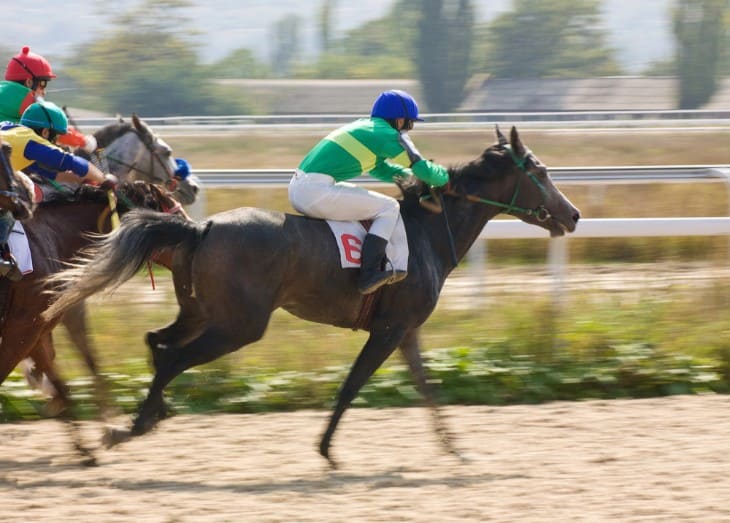Introduction
In horse racing, track conditions play a crucial role in determining the outcome of races. These conditions refer to the state of the racetrack's surface, which can vary due to weather conditions such as rain. The condition of the track is assessed by track officials and is communicated to trainers, jockeys, and bettors to help them make informed decisions about the race.
Yielding refers to the condition of the racetrack surface. The track condition is important because it affects how fast horses can run and how they perform during a race.
Yielding is a term used to describe a track condition that is neither hard nor soft but somewhere in between. It typically occurs when there has been some rain, and the ground is soft and slightly muddy. A yielding track can be a bit challenging for horses to run on because it offers more resistance than a firm track but less than a soft or muddy track.
Track conditions are usually assessed by officials and are indicated in the race program or announced at the track before the races begin. Trainers and jockeys take track conditions into account when deciding on race strategy and selecting suitable horses for specific races because different horses perform better on different track surfaces.
A Fine Line Between Hard, Yielding and Soft Track
The classification of track conditions in horse racing is somewhat subjective and can vary between racing jurisdictions. However, there are general guidelines that help define the line between different track conditions. Here's a breakdown of the typical distinctions between hard, yielding, and soft tracks:
- Hard Track: A hard track is dry and firm. It has little to no give, meaning the surface is solid and provides maximum support for the horses' hooves. A track is considered hard when it has received minimal or no rainfall for an extended period. Horses can achieve their fastest speeds on a hard track due to the minimal resistance.
- Yielding Track: A yielding track falls between hard and soft. It indicates that there has been some rainfall, but the track has not become excessively muddy. A yielding track has a bit of cushioning, offering some resistance while allowing horses to sink into the surface slightly. It's softer than a hard track but firmer than a soft track.
- Soft Track: A soft track is significantly wetter and muddier than a yielding track. It results from consistent or heavy rainfall. Soft tracks provide substantial cushioning but can become tiring for horses as they need to exert more effort to push through the softer ground. Horses that perform well on soft tracks often have a strong ability to handle such challenging conditions.
It's important to note that the classification of track conditions is typically determined by track officials or stewards. They use a penetrometer, a device designed to measure the softness or hardness of the ground, to assess the track condition accurately. The penetrometer readings, combined with visual inspections, help in categorizing the track.
These categories are essential for trainers, jockeys, and bettors as they provide valuable information about the likely performance of horses in specific weather and track conditions. Horses often have preferences for certain track surfaces, so understanding these conditions is crucial for making informed decisions in horse racing.

Yielding Track – The Effect On Horses
Trainers and jockeys carefully consider the track conditions when choosing races for their horses. Some horses excel on yielding tracks, while others might struggle. Therefore, knowledge of a horse's past performances on similar track conditions is crucial for making strategic decisions in horse racing. Additionally, jockeys need to adapt their riding styles based on the track conditions to optimize the horse's performance during the race.
- Traction and Stride: On a yielding track, the surface is softer, providing more traction than a hard track. Horses can dig their hooves into the ground slightly, allowing for a better grip. This can be advantageous for horses that have a strong finishing kick, as they can push off the ground effectively in the latter part of the race.
- Energy Expenditure: Horses running on a yielding track need to exert more energy with each stride due to the slightly softer ground. As a result, they might tire more quickly, especially if the race is of a longer distance. Horses that are accustomed to yielding tracks and have good stamina are better equipped to handle the increased effort required.
- Pace Variation: The pace of the race can be influenced by the track condition. Some horses may struggle to maintain a fast pace on a yielding track, leading to a slower early pace in the race. Conversely, horses with a strong kick might benefit from a slower pace, allowing them to conserve energy for a powerful finish.
- Fitness and Conditioning: Horses that are well-conditioned and fit tend to perform better on yielding tracks. Fitness helps them sustain their speed and energy levels throughout the race, allowing them to handle the additional effort required on a softer surface.
- Hoof Health: The condition of the track, especially if it's muddy, can affect the health of a horse's hooves. Trainers and handlers need to pay close attention to hoof care, ensuring that the horses' feet are properly maintained to prevent injuries or discomfort during the race.
- Experience and Adaptability: Horses that have experience racing on different track conditions, including yielding tracks, tend to adapt better. They understand how to navigate the surface and can adjust their stride length and pace accordingly.
Yielding Track – The Effect on Jockeys
Jockeys on yielding tracks need to strike a balance between conserving energy, assessing the race's pace, adjusting their riding style, avoiding kickback, leveraging their knowledge and experience, and maintaining strong mental composure. These skills are crucial for jockeys to make informed decisions and guide their horses to optimal performances on yielding tracks.
- Conserving Energy: Jockeys must be mindful of the energy expenditure on a yielding track. The softer surface means horses need to exert more effort with each stride. Jockeys may need to conserve their mounts' energy, especially in longer races, to ensure they have enough stamina for a strong finish. This requires expert judgment and timing to maintain a balanced pace throughout the race.
- Pace Assessment: On a yielding track, the pace of the race can be slower in the early stages due to the additional effort required by the horses. Jockeys need to assess the pace of the race and make decisions about when to make a move. A well-timed acceleration can be decisive, especially if other horses tire quickly due to the softer ground.
- Adjusting Riding Style: Jockeys might need to adapt their riding style to the yielding track. They may need to encourage their horses more, using subtle cues to maintain motivation and focus. Additionally, jockeys need to be aware of the track's condition to avoid sudden moves that could lead to slips or falls, especially around turns.
- Avoiding Kickback: A yielding track can create more kickback, which is the spray of mud and sand that flies into the air as horses gallop. Jockeys must position their horses strategically to avoid the kickback, as it can affect visibility and make it harder for the horse to breathe comfortably. Being behind or alongside a horse that creates a lot of kickbacks can be a disadvantage.
- Knowledge and Experience: Jockeys with experience riding on different track conditions, including yielding tracks, have a distinct advantage. They understand how horses respond to softer surfaces and can make split-second decisions based on this knowledge. Experienced jockeys also have a better feel for their mounts, allowing them to gauge their horses' reactions to the track conditions.
- Mental Preparation: Jockeys need to be mentally prepared for the challenges posed by a yielding track. Confidence, focus, and adaptability are key mental attributes that help jockeys navigate the race effectively, especially when faced with unexpected situations caused by the track conditions.

What About the Impact on Betting?
Betting on horse races requires a careful consideration of various factors, including the track condition. The impact of a yielding track on betting can be significant and should be taken into account by bettors. A yielding track can create both challenges and opportunities for bettors. By considering a horse's past performance on similar tracks, the skills of the jockey, the distance of the race, pace dynamics, betting odds, and recent form, bettors can make more informed decisions and potentially find value bets in races taking place on yielding tracks.
- Horse Preference: Some horses have a strong preference for certain track conditions. Bettors should research the past performances of horses to see if they have a history of performing well on yielding tracks. Horses that have demonstrated success on similar surfaces in the past might be more reliable bets in such conditions.
- Jockey Skill: Experienced jockeys who are adept at riding on yielding tracks can make a difference. Bettors should consider the jockey's track record on softer surfaces and their ability to adapt to varying conditions. Jockeys with a history of successful rides on yielding tracks might increase the chances of their mounts performing well.
- Distance Consideration: The length of the race is crucial for yielding tracks. Longer races can be more challenging for horses due to the additional effort required on the softer surface. Bettors should consider the distance of the race and assess whether the horses in question have the stamina to maintain their performance on a yielding track, especially in longer races.
- Pace Analysis: Yielding tracks can affect the pace of the race. Some horses might struggle with an altered pace, while others may benefit. Bettors should analyze the early speed in the race and consider how it might affect the frontrunners and closers, as different horses respond differently to the changed pace dynamics.
- Betting Odds: The betting odds offered on horses can be influenced by the track condition. Horses that have a strong record on yielding tracks might be more heavily favoured by the betting public. Understanding how the odds reflect a horse's past performances on similar surfaces can help bettors make value bets.
- Fitness and Recent Form: Horses that are well-conditioned and have shown recent good form on yielding tracks or similar conditions are often safer bets. Bettors should look for horses that have had recent successful outings on softer surfaces and are in good physical shape.
- Weather Updates: Weather conditions can change rapidly, affecting the track condition. Bettors should stay updated with weather forecasts and track condition announcements as they can influence a horse's performance. Unexpected weather changes might favour certain horses more than others, leading to potential betting opportunities.
Summary
In horse racing, a yielding track falls between a hard and soft surface, offering some cushioning while requiring horses to exert more effort. This intermediate condition affects horses' traction, energy expenditure, and overall performance. Experienced jockeys who can adapt their riding style and conserve their horses' energy excel on yielding tracks. For bettors, understanding horses' past performance on similar surfaces, jockeys' skills, and the influence of the changing pace dynamics is crucial. Bettors should also consider the distance of the race and stay updated on weather conditions to make informed betting decisions on yielding tracks.
For more information:








